Diogo Montteiro looks at the various unusual 747 variants.
The 747 is unarguably the Queen of the Skies. After its first flight in 1969, the doubledecker entered the History of aviation through its unique design. 51 years after her inaugural flight, the Queen still manages to turn necks and attention at the airports in which she still operates. Due to its versatility and fame, there were several 747s that, over the years, have been modified and readjusted to serve purposes other than regular passenger transport. With new models, more modern and efficient to be launched in the market and with the reduction of global fleets due to the COVID-19 pandemic, the 747 was gradually being withdrawn of operation, becoming more and more rare to be seen in the main airports around the world.
This article talks about the 747 that have been modified and made even more unique, throughout history.
Shuttle Carrier Aircraft (SCA)
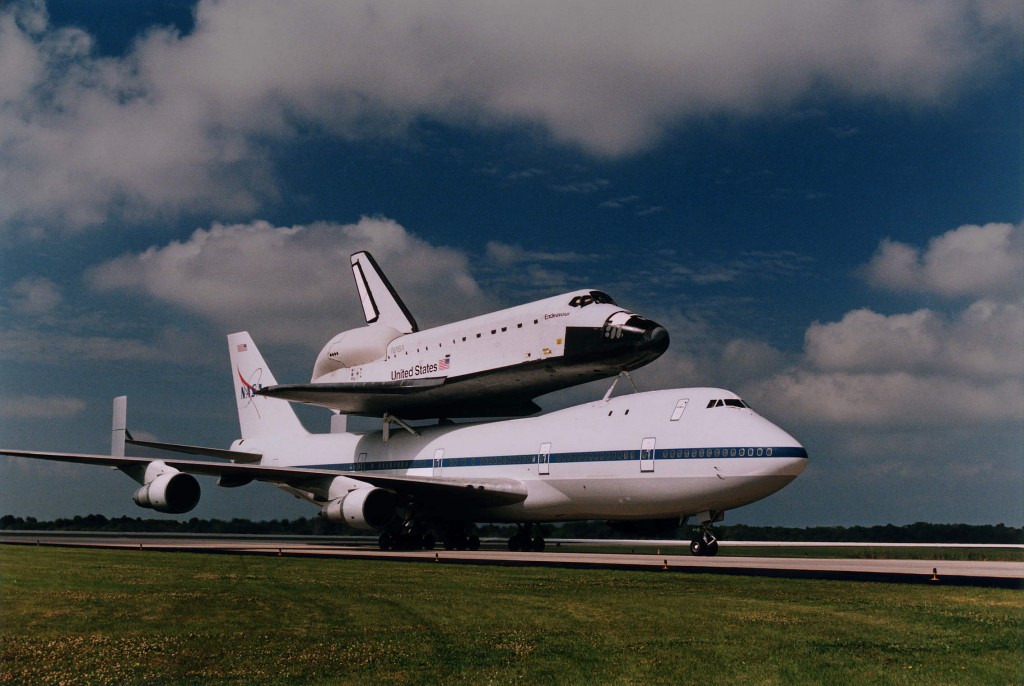
The SCA are two modified Boeing 747s used by NASA to transport the Space Shuttle between the Space Shuttle landing points and the Shuttle’s landing facility at Kennedy Space Center (Florida).
The first 747 to be modified was the N905NA. A Boeing 747-123 that was originally scheduled to be delivered to American Airlines. In 1974 American Airlines resold this 747 to NASA, which maintained the AA base livery during Space Shuttle Enterprise tests until 1983 when NASA introduced its own paint scheme on the plane.
The fuselage of this 747 was extensively modified and reinforced by NASA in 1976 and the cockpit had an avionics upgrade to smooth and reduce the crew’s workload. While American Airlines first-class seats have been maintained to accommodate NASA passengers and crews, the main cabin as well as the primary insulation have been removed to add mounting brackets.
Due to the weight and location of the Space Shuttle that would be on top of the plane, the 747’s center of gravity was changed, so it was necessary to install vertical stabilizers in the tail, to increase stability when the Shuttle was being carried on the 747.
Also due to weight and additional drag the Space Shuttle superimposed on the 747, the aircraft in terms of performance was seriously limited in its range due to the high fuel consumption.
The 747’s range has been reduced to 1,000 nautical miles (1,900 km) compared to 5,500 nautical miles (10,200 km) without additional charge. This required several operational stopovers to refuel the SCA in the event of a transcontinental flight. As was the case in 1983 when SCA had to land in Goose Bay (Canada), Keflavik (Iceland), England and West Germany when it took the Space Shuttle Enterprise on a tour through Europe.
As far as altitude is concerned, the 747 SCA had a maximum altitude ceiling of 15,000 ft (4,600 m) and a maximum cruising speed of Mach 0.60 with the Shuttle attached. Without the Shuttle attached, the 747 needed to fly with ballast to keep the new center of gravity within operational limits.
In 1988, in the wake of the Space Shuttle Challenger accident, NASA bought a surplus 747SR-46 from JAL – Japan Airlines. Registered as N911NA, it entered service for NASA in 1990 after undergoing modifications similar to those perpetuated on N905NA. It was first used in 1991 to ferry the new Space Shuttle Endeavor from the manufacturers in Palmdale, California to Kennedy Space Center.
With the end of the Space Shuttle program, NASA phased-out the two 747 Shuttle Carrier Aircraft in 2012. The N911NA is now preserved and on display at the Joe Davies Heritage Airpark in Palmdale, California while the N905NA is on display with mockup Space Shuttle Independence at Space Center Houston since 2016.
The Stratospheric Observatory for Infrared Astronomy (SOFIA)
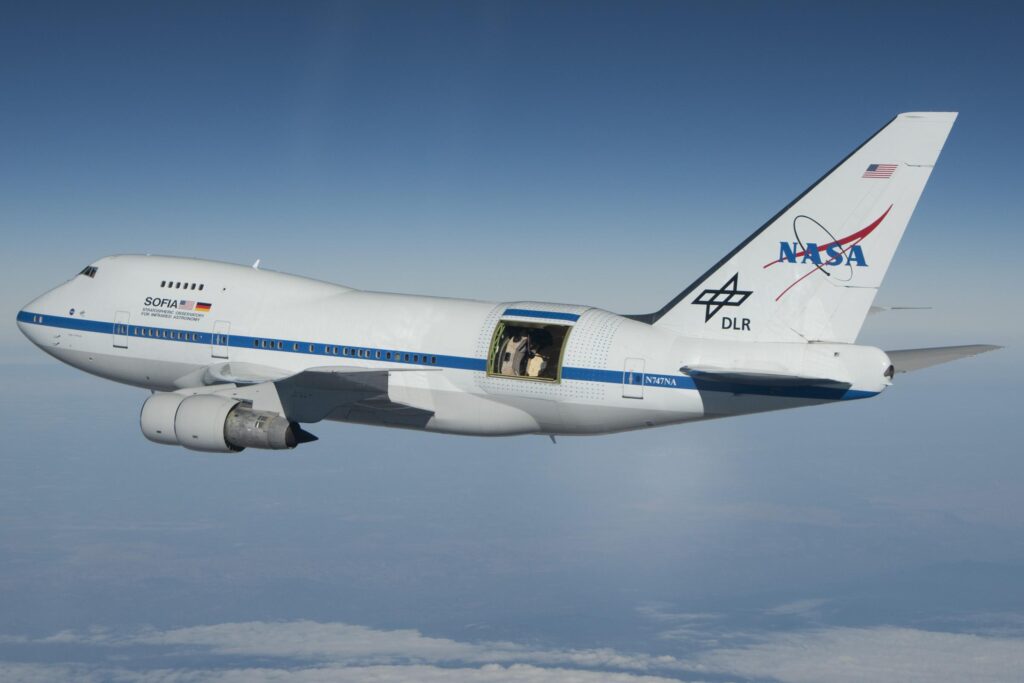
Photo: NASA/Jim Ross
The Stratospheric Observatory for Infrared Astronomy (SOFIA) is an 80/20 joint project of NASA with the German Aerospace Center to construct and maintain an airborne observatory. During 10-hour, overnight flights, it observes celestial magnetic fields, starforming regions, comets, nebulae, and the galactic centre.
The SOFIA aircraft is a modified Boeing 747SP with registration N747NA and with the callsign “NASA747”. It flew for the first time in May 1977 with Pan Am. In October 1997 NASA acquired this 747SP and still in 1997, NASA made several test
flights on the plane before it went through a serious and profound intervention that would be carried out by Raytheon Intelligence and Information Systems
Starting work in 1998, Raytheon designed and introduced a 5.5-meter high by 4.1-meter-wide door on the left side of the 747 fuselage that can be opened during flight to provide the telescope access to the sky.
The telescope is mounted at the rear end of the fuselage, behind a pressurized bulkhead. The focal point of the telescope is located on a set of scientific instruments in the central pressurized section of the fuselage, requiring part of the telescope to pass through the pressure bulkhead. At the center of the aircraft is the mission control and scientific operations section, while the front section integrates the area of education and publicity. The open fuselage has no significant influence on the aerodynamics and flight qualities of the plane.
SOFIA’s inaugural flight took place on April 26, 2007 and on May 31, 2007, SOFIA was transferred to NASA’s Armstrong Flight Research Center at Edwards Air Force Base (California). The first phase of loads and flight testing was used to check the aircraft characteristics with the external telescope cavity door closed. This phase was successfully completed by January, 2008. On December 2009, SOFIA performed the first test flight in which the telescope door was fully opened. This phase lasted for two minutes. SOFIA’s telescope saw for the first time the sky light on May 26, 2010, returning images showing M82’s core and heat from Jupiter’s formation escaping through its cloud cover.
The Boeing VC-25A
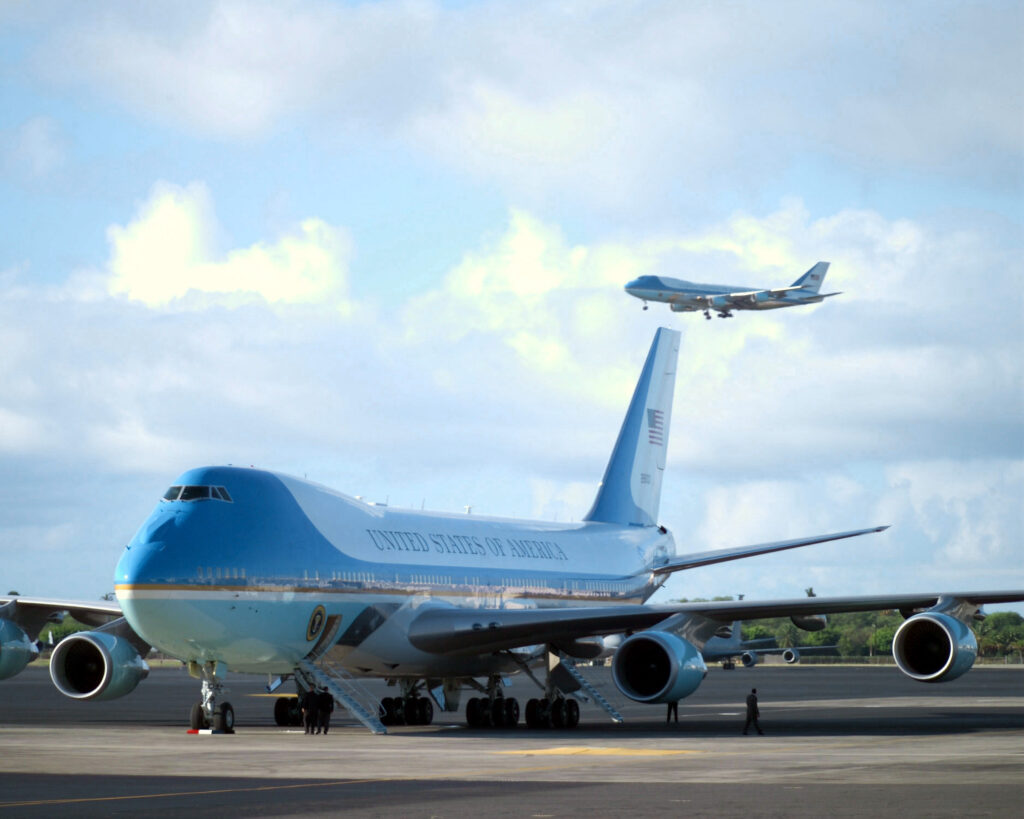
Air Force One lands at Hickam Air Force Base (AFB) with US President George W. Bush on board for his first visit to Hawaii while holding office.
The Boeing VC-25A are two highly modified Boeing 747s used by the USAF for the transportation of the President of the United States of America or high patents of American policy that came to replace the VC-137C. Whenever POTUS is on board one of the two Boeing VC-25A, the aircraft’s callsign automatically switches to “Air Force One”, the name by which these Boeing 747s are popularly known.
With tail numbers of 28000 and 29000, the VC-25A were built in 1986 and flew for the first time in 1987 while Ronald Regan was in office. The interior designs were created by then First Lady Nancy Regan who was inspired by designs that resemble the American Southwest. However, problems with the communication wires inside the aircraft delayed their delivery until 1990, already during the Administration of George H. W. Bush.
The VC-25A are capable of flying 7,800 nautical miles (12,600 km) without refueling. However, both planes are equipped with an in-flight refueling system that, in theory, allows the VC-25A to have an unlimited range. Among more general characteristics, the Boeing VC-25A has a crew of 26 elements: 2 pilots, 1 flight engineer, 1 navigator, plus cabin crew and mission crew. Even though its 370 m² of space has been reconfigured for presidential functions, it is still possible to accommodate 76 passengers in a VIP configuration.
This aircraft can also be operated as a military command center in the event of a serious incident, such as a nuclear attack. The immense modifications perpetuated by the USAF to the VC-25A include anti-aircraft missile countermeasures.
In terms of avionics and electronics, the VC-25A have 383 km of wire that are covered with heavy protective shields to protect them from electromagnetic nuclear pulses, thus guaranteeing their airworthiness in the event of a nuclear attack.
Many VC-25A countermeasures are top secret, however it is common knowledge the aircraft also has electronic countermeasures (ECMs) to jam enemy radar, flares to avoid heat-seeking missiles, and chaff to avoid radar-guided missiles. All small arms and ammunition stores not in the physical possession of the Secret Services on board the VC-25s are stowed and secured by the Secret Services in separate locked compartments, each with a different locking mechanism for added security.
In terms of performance, the VC-25A is powered by 4 General Electric CF6-80C2B1 engines that provide a maximum speed of approximately 548 knots (1,014 km/h) or Mach 0.92 at 35,000 ft with a service ceiling of 45 100 ft (13,700 m). In terms of
limitations, the VC-25A has an MTOW of 377,842 kg.
The Boeing VC-25A is also known as “The Flying White House” because it allows POTUS to work and perform its functions as if it were in the White House. At the front of the plane is the presidential part: The President’s Presidential Suite, which includes bedrooms with sofas that can be converted into beds, as well as a fully equipped bathroom, even with shower and a private office: “The Oval Office aboard Air Force One”.
The aircraft also contains a conference room, originally designed as a situation room, but its normally used for meetings between the staff while traveling. The VC-25A has fully equipped office areas with telecommunication systems. The area where the guests stay is located in the middle of the plane, outside the “White House” area. There are separate rooms for guests, senior staff, Secret Services and security personnel, and the news media located in the aft area of the main deck.
On board the VC-25A there is a medical facility that includes a fold-out operating table, emergency medical supplies, and a well-stocked pharmacy. Every flight is staffed by a doctor and nurse. The Boeing VC-25A is expected to continue to fly until 2024, the year in which the Boeing VC-25B, a new model based on the Boeing 747-8i, is expected to enter on service, replacing the current Boeing VC-25A.
Boeing 747 Supertanker
The 747 Supertanker is an aerial firefighting plane derived from the Boeing 747. It is considered the largest firefighting plane in the world, certified to carry up to 74,000 litres of water or fire retardant.
This project was initially developed by Evergreen International Aviation, which designed 2 Supertankers, the first of which was based on the 747-200, with registration N470EV (LN 237), which never got to fly.
The second was based on a 747-100 (N479EV) (LN 94) that was initially developed for Delta Air Lines in 1971. It first entered service in 2009 in Spain and currently no longer flies.
The third 747 Global SuperTanker was developed by Global Supertanker Services, which currently owns and operates the aircraft. This airplane is based on the Boeing 747-400 and has the registration N744ST and named as “The Spirit of John Muir”. It received certification for firefighting flights by the FAA in 2016.
Before being hired by the US Officials to fight the devastating fires in the State of California in 2017, has already participated in missions in Israel and Chile as well as in Bolivia, already in 2019.
The 747 Global SuperTanker is equipped with a pressurized liquid drop system, which can disperse fire retardant under high pressure or drop fire retardant at the same speed of falling rain.
Using its pressurized system, the 747 SuperTanker can provide fire retardant while flying at a height of between 400 to 800 feet (120-240 m), at approximately 140 knots (260 km/h), in approach configuration. However, the Global Supertanker tank system can be configured for segmented discharges, which allows the tank’s contents to be released in various segments during the flight.
According to Global Supertanker Services, the 747 can launch a fire-retardant strip of 4.8 km in length and up to 46 m.
The 747 Global SuperTanker is operated by 2 pilots and a Drop System Operator and contains 12 Business Class Seats, 2 Crew Bunks, and can carry up to 16 Persons.
In terms of performance, the Boeing 747 Global SuperTanker has a range of 7,670 nautical miles (12,344 km) with a maximum altitude ceiling of 45,100 ft (13,746 m) powered by 4 General Electric CF6-80C2B1F Engines with 63,300 pounds of thrust. The cruising speed of 970 km/h (520 knots) allows the 747 Global SuperTanker to reach any point in the United States in 5 hours and in almost any part of the globe in 20 hours.
United States Air Force E-4B

Balon Greyjoy, CC0, via Wikimedia Commons
While the Boeing VC25-A can be considered the Flying White House, the Boeing E-4B can be considered the Flying Pentagon. This military 747 is warmly dubbed the “Doomsday Plane” so the day when POTUS takes off aboard the “Nightwatch” (The Project Name) is certainly not going to be a good day.
Basically, the Boeing E-4B Advanced Airborne Command Post (AACP), is a military strategic command and control aircraft that is operated by the USAF. The E-4B Series consists of 4 aircraft and has been specially modified from the original Boeing 747-200B to the National Emergency Airborne Command Post (NEACP) program.
The E-4B serves as a mobile survival command post for the National Command Authority, which includes the President of the United States (POTUS), the Secretary of Defense and his successors.
During the development of the aircraft, two were originally built for commercial airlines, but after failing the order, Boeing offered these two 747-200 to the USAF as part of a package that would take the replacement of the obsolete EC-135J NEACP.
In 1973 Air Force Electronic Systems Division awarded Boeing a contract for two aircraft, designated E-4A, powered by four Pratt & Whitney JT9D engines, to which a third would be added in July, with the first Boeing E-4A completed at Boeing factory in Seattle in 1973. This last third aircraft differed in that it was powered by the General Electric F103 engines, which was later standardized and adapted for the two previous aircraft. The model A effectively had the same equipment as the EC-135, but offered more space and the ability to remain in the air for longer than an EC-135.
The first Boeing E-4 was delivered in July 1973 to Andrews Air Force Base in Maryland. There followed two next ones that were delivered in October 1973 and October 1974. In December 1973, a fourth aircraft was ordered.
This would be equipped with more advanced equipment however, many older aircraft have been upgraded with glass cockpits, the E-4B still uses traditional analog flight instruments as they are less susceptible to damage from an EMP explosion.
In early 1985, all Boeing E-4As were adapted to the E-4B models. The E-4B offered a large increase in communication capacity over the E-4A and was considered “hardened” against the effects of the nuclear electromagnetic pulse (EMP) from a nuclear explosion.
The E-4B was designed to survive an EMP with the systems intact and has state-of-theart direct countermeasures and also has the in-flight refueling system being able to remain in the air for a considerable period, limited only by the consumption of engine lubricants and the E-4B is designed to stay airborne for an entire week in an emergency. The E-4B has three operational decks: an upper, intermediate and lower.
In terms of performance, the E-4B has a flight crew of 4 elements that can reach up to 108 if the crew mission is counted. It has an MTOW of 377,842 kg and thanks to the 4 General Electric engines it can reach a top speed of 523 knots (969 km/h). However, its cruising speed is Mach 0.84 which is equivalent to 525 knots (895 km/h). Its range is up to 6,200 nautical miles (11,500 km) and has a range of more than 150 hours (with inflight refueling)
Boeing 747 Dreamlifter
The Boeing 747 Dreamlifter, also known as Boeing 747-400 Large Cargo Freighter (LCF), is a widebody cargo aircraft that has been modified from the Boeing 747-400. Compared to a Boeing 747-400F, the 747 Dreamlifter has a volume of 1,840 m³, thus, being able to carry three times more cargo.
Like the Airbus A300-600ST Beluga and Beuga XL, the Dreamlifter is mainly used to transport components from other aircraft within its non-pressurized hold, mostly from the Boeing 787 from the various supplier production sites to the Boeing factory, located in Everett, just outside Seattle.
The Dreamlifter arose out of Boeing’s need to transport parts of the Boeing 787 that were too large for sea and land transport. In addition to not fitting in the containers, it would take a long time for the pieces to reach the assembly line. Aircrafts such as the Boeing 747-400F and even the holds of the giants Antonov An-124 and Antonov An-225 were
small for the transport of the 787 parts in a whole.
Initially, to make the Dreamlifter program, Boeing reacquired four 747-400 to be converted into an outsize configuration in order to ferry sub-assemblies from Japan and Italy to Everett for final assembly:
• N249BA – LN 766 (ex China Airlines – B-161);
• N780BA – LN 778 (ex China Airlines – B-162);
• N747BC – LN 904 (ex Air China – B-2464);
• N718BA – LN 932 (ex Malaysia Airlines – 9M-MPA);
The first 747 Dreamlifter, the N747BC, was rolled out from the hangar at Taipei International Airport on August 17, 2006, and then completed its first test flight on September 9th from that same airport. On the 16th of that month, the N747BC arrived at Boeing Field to complete the flight test program. The second aircraft, the N780BA, made its inaugural flight on February 16, 2007 and the third began to be modified in 2007. The first two Dreamlifter’s went into operation in 2007 to assist in the production of the 787 Dreamliner while the third became operational in June 2008 and the fourth and last in February 2010.
Its features do not differ much from the Boeing 747-400F. To fly the Dreamlifter a crew of 2 pilots is required. The Dreamlifter has an MTOW of 364,235 kg. Operating with his MTOW, the Dreamlifter requires 2,804 meters of runway to stay airborne. With its 4 Pratt & Whitney PW4062 engines, each producing 63,300 lbf it has a maximum range of 4,200 nautical miles (7,800 km) at a cruising speed of Mach 0.82 (747 knots / 878 km/h). Its fuel tank capacity stands at 199,150 litres.
B747 Pratt & Whitney Tester
P&W uses two slightly modified Boeing 747SPs to load a fifth engine, not on the wing, but on a separate aerofoil near the 747 hump to test conceptual engine designs in real flight conditions before they go into production. For engines to receive approval for use, they need tests done under uncontrollable conditions, such as temperature variations and providing a boost in speed.
Inside the plane, the interior lacks the standard layout of a commercial aircraft. Instead, P&W used the space for several different workstations for flight test engineers. Each station measures different stages of the engine and can update flight settings to optimize the new engine. Test flights can sometimes take up to eight hours.
In the past, Pratt & Whitney had used a different 747 and would either replace one of the four engines or put it in the “fifth capsule” (position Qantas used to transport engines), which had some disadvantages in relation to this new engine project.
Pratt & Whitney is not the only engine manufacturer who operates slightly modified Boeing 747’s for engine testing. General Electric itself uses the 747 to test its engines, the last of which they tested was the new GE9X designed for the brand-new Boeing 777X.
The Boeing 747SPs that Pratt & Whitney Engine Services operates are:
• C-FPAW – -LN 467 (ex CAAC – Civil Aviation Administration of China – N1304E);
• C-GTFF – LN 507 (ex Korean Air Lines – HL7457);



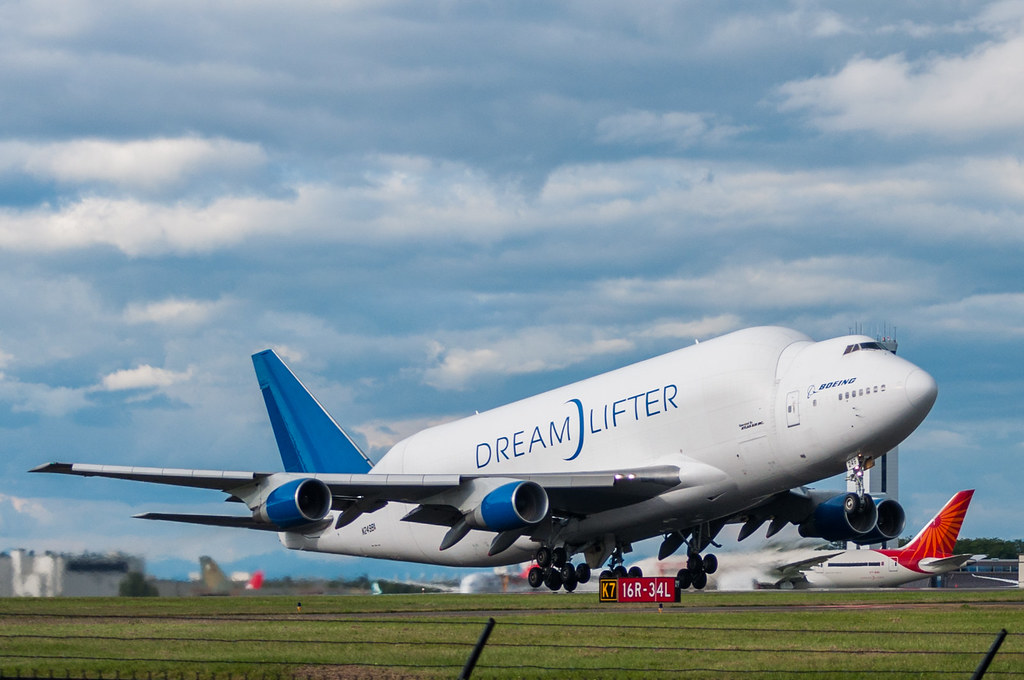
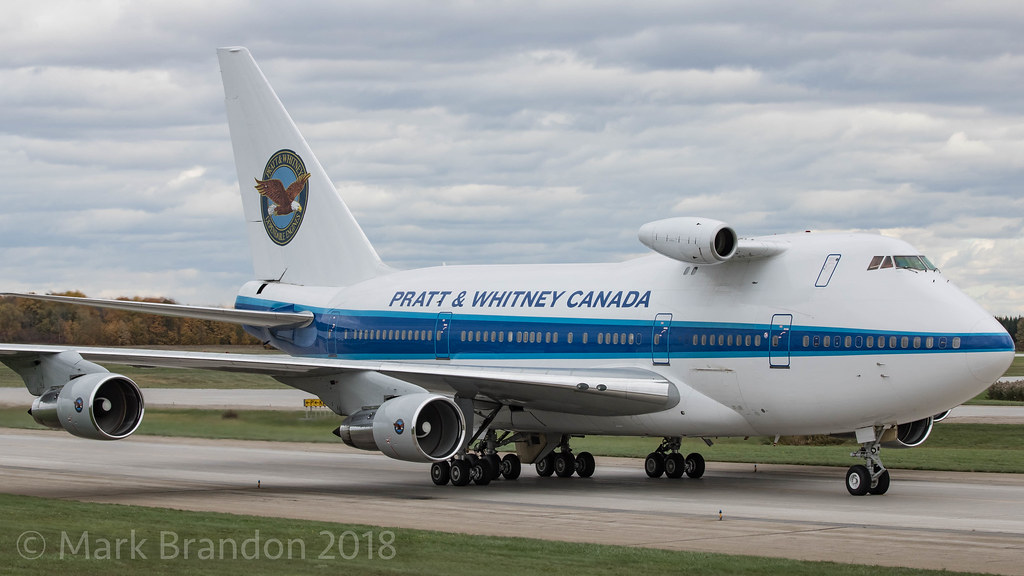



4 comments
Don’t forget the YAL-1 airborne laser testbed.
Good point, thanks Alex!
The NASA 747 N905NA we had a look round the outside at Marana in July 1993 while on a full day at Marana (in 100F)
The SOFIA B747SP, my wife and I flew on it when it was N536PA with PANAM, on 5th June 1979, SFO/LAX.
The VC-25 ”31677” was in Perth 13th Nov. 2012 for a CHOGM Commonwealth Heads of Govt. Meeting. and had a good look round the exterior.
Count myself very fortunate indeed to have flown on the 100/200/200SP/300/400 and 400ER, models. and quite a few jump seat rides as well…magic !
[…] A number of special, modified variants of the 747 have been produced and they are described in detail here: https://www.airportspotting.com/the-modified-boeing-747s/ […]